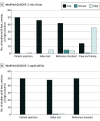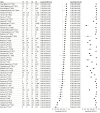Sensitivity and Specificity of the Modified Checklist for Autism in Toddlers (Original and Revised): A Systematic Review and Meta-analysis
- PMID: 36804771
- PMCID: PMC9941975
- DOI: 10.1001/jamapediatrics.2022.5975
Sensitivity and Specificity of the Modified Checklist for Autism in Toddlers (Original and Revised): A Systematic Review and Meta-analysis
Abstract
Importance: The Modified Checklist for Autism in Toddlers (M-CHAT) and the M-CHAT, Revised With Follow-up (M-CHAT-R/F)-henceforth referred to as M-CHAT(-R/F)-are the most commonly used toddler screeners for autism spectrum disorder (ASD). Their use often differs from that in the original validation studies, resulting in a range of estimates of sensitivity and specificity. Also, given the variability in reports of the clinical utility of the M-CHAT(-R/F), researchers and practitioners lack guidance to inform autism screening protocols.
Objective: To synthesize variability in sensitivity and specificity of M-CHAT(-R/F) across multiple factors, including procedures for identifying missed cases, likelihood level, screening age, and single compared with repeated screenings.
Data sources: A literature search was conducted with PubMed, Web of Science, and Scopus to identify studies published between January 1, 2001, and August 31, 2022.
Study selection: Articles were included if the studies used the M-CHAT(-R/F) (ie, original or revised version) to identify new ASD cases, were published in English-language peer-reviewed journals, included at least 10 ASD cases, reported procedures for false-negative case identification, screened children by 48 months, and included information (or had information provided by authors when contacted) needed to conduct the meta-analysis.
Data extraction and synthesis: The systematic review and meta-analysis was conducted within the Preferred Reporting Items for Systematic Reviews and Meta-analyses (PRISMA) reporting guideline. The Quality Assessment of Diagnostic Accuracy Studies-2 tool evaluated bias in sample selection. Data extraction and quality assessment were performed by 2 authors independently. The overall diagnostic accuracy of the M-CHAT(-R/F) was assessed with the hierarchic summary receiver operating characteristic (HSROC) model.
Main outcomes and measures: Sensitivity, specificity, diagnostic odds ratios, and HSROC curves of M-CHAT(-R/F).
Results: The review included 50 studies with 51 samples. The pooled sensitivity of M-CHAT(-R/F) was 0.83 (95% CI, 0.77-0.88), and the pooled specificity was 0.94 (95% CI, 0.89-0.97). Heterogeneity analyses revealed greater diagnostic accuracy for low- vs high-likelihood samples, a concurrent vs prospective case confirmation strategy, a large vs small sample size, use of M-CHAT(-R/F) Follow-up, and non-English vs English only.
Conclusions and relevance: Overall, results of this study suggest the utility of the M-CHAT(-R/F) as an ASD screener. The wide variability in psychometric properties of M-CHAT(-R/F) highlights differences in screener use that should be considered in research and practice.
Conflict of interest statement
Figures



Comment in
-
Screening Success in the Age of Autism.JAMA Pediatr. 2023 Apr 1;177(4):331-332. doi: 10.1001/jamapediatrics.2022.5972. JAMA Pediatr. 2023. PMID: 36806882 No abstract available.

